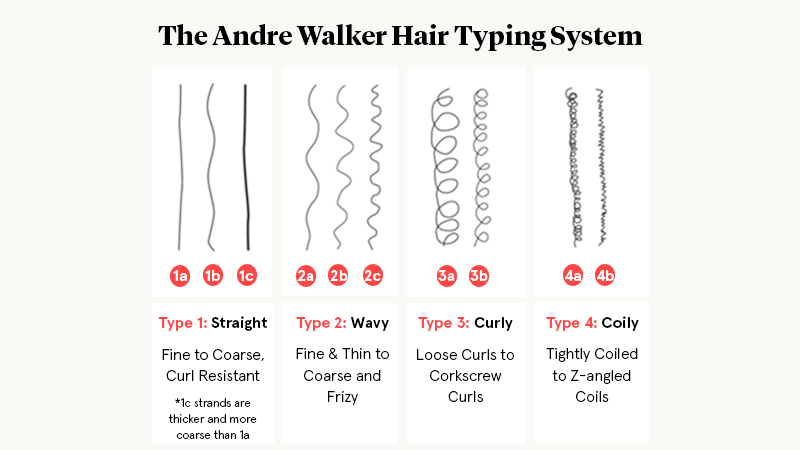How To Identify and Maintain Different Types of Men's Hair

If you’re like a lot of guys, you probably don’t know what type of hair you have. “Of course I do,” you might be saying in response to that, “it’s curly!” You’d be right to say that—curly is a general type of hair.
But getting more specific than that is a necessary step toward making your hair the best it can be. That’s because your hair type will help you figure out what kinds of styling products you should be using to maximize your hair’s health and appearance.
What does “hair type” mean?
In general, your hair type refers to how curly or straight it is, which is called your “curl pattern.” (If you have straight hair, your curl pattern is…straight. Bet you didn’t see that one coming.) Your curl pattern is determined by the shape of your hair shaft—curly hair is oval-shaped, straight hair is round, and coily hair is flat.
The shape of your hair shaft, and therefore how curly or straight your hair is, is in your DNA. Heat from blow dryers and flat irons and chemical treatments like relaxers can temporarily change your curl pattern, but as your hair goes through its stages of growth, your natural curl pattern will reappear. That said, certain medical treatments, such as chemotherapy, can permanently alter the appearance of your hair.
Here are the broad categories everyone’s hair falls into:
- Straight
- Wavy
- Curly
- Coily (sometimes called “kinky”)
These are the hair types you’re probably already familiar with. But to really help you make the most of your hair, we’re going to have to get more specific.
What are the specific types of hair?

The most popular system for categorizing hair was created by Andre Walker, Oprah’s longtime stylist, in a book called Andre Talks Hair!. Walker’s system has plenty of critics and is by no means perfect, but we’re going to focus on it here because it’s the most widely-known way of classifying hair.
Walker uses the broad categories listed above, but assigns them numbers: straight is 1, wavy is 2, curly is 3, and coily is 4. On top of that, he adds letters (A, B, and C) that indicate how tight or loose your curl is. That’s useful because two people with curly hair might have very different challenges if one person’s hair is more tightly curled.
One thing to note is that your curl pattern might not be consistent throughout your whole head. For example, even if most of your hair is 3B according to Walker’s system, you might find that the hair around your temples or at your hairline is 3A.
Knowing not just your category but also your subcategory is the key to getting the most bang out of the bucks you’re spending on styling products, shampoo, and conditioner. So let’s dive in.
Straight
Walker classifies straight hair as Type 1. Straight hair lacks a visible curl pattern, which makes it easy to distinguish from other hair types. It’s less vulnerable to damage from unfriendly weather and elaborate styling (think: teasing, braiding, curling, and blow drying) than other types. And because it gives your hair’s natural oil (known as sebum) a clear path from the scalp to the ends, this type is naturally shiny. But that shine can quickly start to look oily if the hair isn’t properly cared for.
There are three subtypes of straight hair: 1A, 1B, and 1C. Your subtype depends on how fine or coarse your individual hair strands are. The thinnest of straight strands are 1A, medium is 1B, and 1C is the thickest. If you can’t figure out what subtype your hair falls into, try searching “1B hair” and looking at images to figure out if your hair matches what you’re seeing. You could also try asking your barber or stylist if they’re familiar with Walker’s system.
The most important thing to remember about this hair type is that it tends to get oily, so you’ll want to avoid creamy, thick products that’ll add unnecessary oil to your hair. (If you’re closer to 1C than 1A, though, you might be able to get away with some creamier products.) Be sure to shampoo to get rid of buildup. Dry shampoo is a great option for keeping your hair clean without having to hop in the shower too often. Also consider trying a volumizing or thickening conditioner, which tend to be less weighty than other types of conditioner.
Wavy
Wavy hair is type 2. You’ll know you have wavy hair if it has a discernible curl pattern, but you’d hesitate to call it “curly.” Wavy hair is less likely to get oily than straight hair, but more likely to frizz out.
For this and curlier hair types, the subcategories play a more important role in determining which products are best for you. Here’s how to know if you have 2A, 2B, or 2C hair:
- 2A: You can easily straighten and style your hair. The individual strands are thin.
- 2B: Your hair is more resistant to styling. The strands are on the thicker side.
- 2C: Your hair refuses to give up its natural curl pattern no matter what you do. The individual strands are thick, and your hair is prone to frizziness.
If you have 2A hair, your loose, thin waves can easily get overwhelmed by creamy products, resulting in a flat, weighed-down appearance. Instead, try mousses or gels, which are typically lighter.
2B and 2C hair is thicker and more defined, making heavier products an option. Oils and moisturizers can help keep your natural curl pattern from disappearing under a layer of frizz. Look for “anti-humidity” or “anti-humectant” on the label, especially if you have 2C hair.
Curly
Type 3 is curly hair. This curl pattern is more defined than wavy hair, but less than coily hair. Curly hair is usually thick, easily damaged, and prone to frizz in humid climates. Depending on subtype, its appearance can range from loose curls to a corkscrew shape.
Andre Walker’s original system included only two subtypes of curly hair: 3A and 3B. 3C was added by members of the natural hair community, which fights the stigma against curls and coils by advocating for loving your hair the way it looks naturally. Given how important the subtypes are for non-straight hair types, the addition of 3C was a necessary step toward making Walker’s system more useful for people who don’t happen to have fine, smooth hair.
Here’s how you can identify 3A, 3B, and 3C hair:
- 3A: Your curls are loose, large, and well-defined.
- 3B: Your curls are tighter, closer to a ringlet shape. They’re coarser and denser than 3A curls.
- 3C: Your curls are dense and corkscrew-shaped, with a circumference about the size of a pencil. 3C hair has more volume than 3A or 3B.
The most important thing to remember about type 3 hair is that you should never brush it. Brushing out your curls is a surefire way to create frizz. Instead, comb it out while you’re in the shower with conditioner in it. If your hair is on the longer side, try to refrain from pulling it back into a bun or ponytail too often. The tension these styles put on your hair not only loosens your curls, but can also cause certain types of alopecia if you’re wearing them on a daily basis.
Type 3 hair needs moisture to avoid frizz, and can handle heavier products than type 2. Anti-humidity products are a good call, but be sure to avoid any that contain silicone and sulfates, which can damage your hair over time.
3C hair needs to be treated a little more gently than 3A and 3B. Don’t use heated styling tools on it, and let it air-dry when you get it wet. Avoid combing too, because it can break more delicate hair. After you shampoo and condition your hair, add a leave-in conditioner and then use your fingers to comb out any tangles. This might sound like a lot of extra work, especially if you have a lot of hair, but you might be surprised by how much better this extra step can make your hair look.
Coily
Type 4 is coily hair (sometimes referred to by the outdated term “kinky”). This kind of hair is tightly curled or has an Afro texture, and shrinks up a lot when it gets wet. Coily hair tends to be thick and dense, which sometimes makes people think it can handle rough treatment. In fact, the opposite is true—this hair type is the most fragile because it has fewer layers of protection (called cuticle layers) than other types. It’s also prone to dryness because it takes longer for natural oils to make their way from the scalp to the ends.
Here’s how to tell the difference between the subtypes of coily hair:
- 4A: Your hair strands are fine or wiry. Your coils have a noticeable and tight curl pattern.
- 4B: Your hair strands might be fine, wiry, or coarse. Your curl pattern is less defined because the coils are so tight, and might resemble a zig-zag pattern.
- 4C: Your strand texture may vary, but your hair is very delicate and prone to breakage. Because of this, you might have difficulty growing it out. Your coils are not as defined as 4A or 4B. (Like 3C, this hair type was added to Walker’s system after it was created.)
Like people with wavy or curly hair, coily-haired folks should focus on maintaining moisture, but they’ll also need to use even gentler products to avoid breakage. Don’t skimp on the conditioner when you’re in the shower, and always follow up with a leave-in conditioner. On days you don’t wash your hair, keep it moisturized with oils, creams, or deep conditioners.
If you have 4B or 4C hair, you should consider skipping shampoo entirely and just washing your hair with conditioner (that’s called “co-washing”), preferably a natural conditioner. Conditioner cleans your hair just as well as shampoo does without stripping it of the oil it needs to look its best. You also might want to pass on the fancier products and just stick to rich natural oils (such as coconut oil or shea butter), because your hair is more sensitive to damaging additives than any other type.
That might’ve been a lot of new information for you, so let’s recap. Knowing your general hair type (straight, wavy, curly, or coily) is a great starting place, but you’ll need to figure out which subcategory your hair falls into to really know how to treat it properly. Your subtype depends on how visible your curl pattern is and how thick your strands are.
Now that you know exactly what type of hair you have, you can buy your next round of styling products with a lot more confidence. It’ll still take some time (and trial and error) to figure out how to help your hair look its absolute best, but this advice should help you zero in on the products that are most likely to work for you.
The information provided in this article is not a substitute for professional medical advice, diagnosis, or treatment. You should not rely upon the content provided in this article for specific medical advice. If you have any questions or concerns, please talk to your doctor.
Photo by Christopher Alvarenga on Unsplash